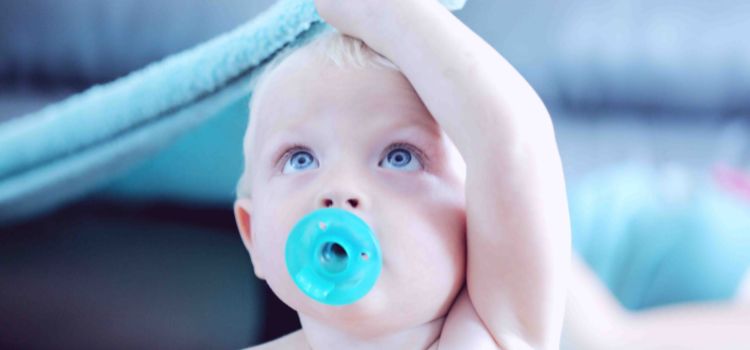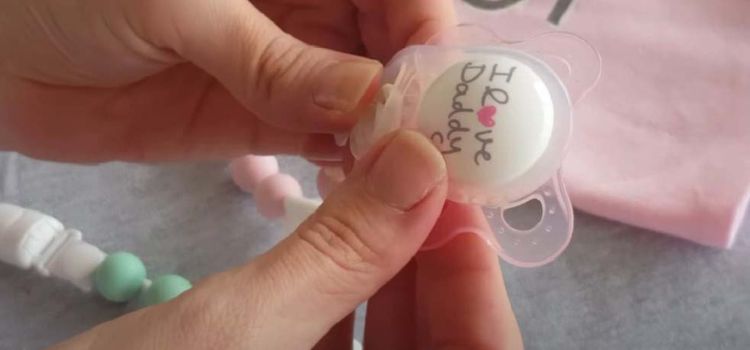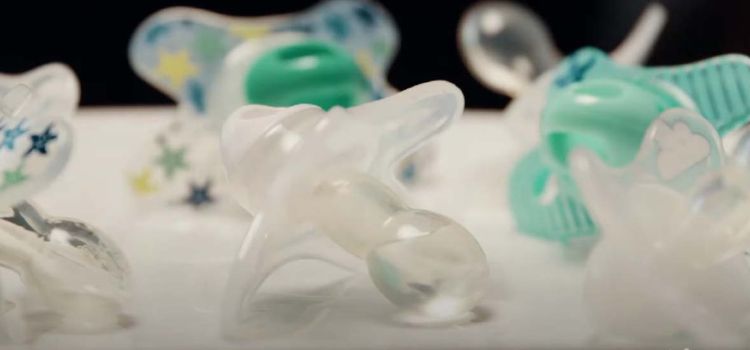As an Amazon Associate I earn from qualifying purchases.
When it comes to sending your little one off to daycare, there are many things to consider. One important aspect is ensuring that your child’s belongings are properly labeled, including their pacifiers.
A seemingly simple practice holds tremendous importance in maintaining hygiene, preventing mix-ups, and creating a seamless caregiving experience. Let’s delve into the world of pacifier labeling, exploring various aspects to make this task not only practical but also a breeze for parents and caregivers.

In this blog post, we will tell you through the process of labeling pacifiers for daycare, providing you with tips and recommendations to keep track of your child’s pacifiers and ensure they are easily identifiable.
Why Label Pacifiers?

Labeling pacifiers is essential for several reasons:
- It helps prevent mix-ups among children, ensuring that your child uses their pacifier and avoids any potential hygiene issues.
- Labeling pacifiers makes it easier for daycare staff to identify your child’s belongings and return them promptly if misplaced.
- It gives parents peace of mind that their child’s pacifiers are tagged and found.
Types of Pacifier Labels
Choosing the right label is essential. Waterproof labels withstand frequent cleaning, customizable labels allow a personal touch, and disposable options provide convenience. Understanding the unique features of each type ensures a tailored approach to your labeling needs.
Choosing the Right Labeling Method

There are several methods you can use to label your child’s pacifiers. Here are some popular options:
1. Permanent Marker: Using a permanent marker is a simple and cost-effective way to label pacifiers. Write your child’s name or initials directly on the pacifier. However, keep in mind that the ink may fade over time and may not withstand frequent washing or sterilization.
2. Label Stickers: Label stickers specifically designed for pacifiers are another popular option. These stickers are typically dishwasher and sterilizer-safe, ensuring that the label stays intact even after multiple washes. Look for labels that are durable, waterproof, and easy to apply and remove.
3. Custom Pacifier Clips: Another creative option is to use custom pacifier clips with your child’s name or initials engraved on them. These clips not only keep the pacifier within reach but also serve
Tips for Labeling Pacifiers

To ensure effective labeling of pacifiers, consider the following tips:
1. Use Clear and Legible Writing: Whether using a permanent marker or label stickers, ensure that the name or initials are written clearly and are legible. This makes it easier for both daycare staff and other parents to read and identify the pacifier.
2. Multiple Labels: It’s a good idea to label the pacifier itself as well as the pacifier case (if applicable). This provides an extra layer of identification, especially if the pacifier gets separated from its case.
3. Regularly Check and Reapply Labels: Over time, labels may fade or peel off due to washing or sterilization. It is important to regularly check the condition of the labels and reapply them if necessary to ensure their visibility and effectiveness.
4. Communicate with Daycare Staff: Tell the childcare workers how you labeled your child’s pacifiers. If your child’s pacifiers go lost, they can immediately find and return them.
Additional Tips for Pacifier Management

In addition to labeling pacifiers, here are a few more tips to help you manage pacifiers effectively:
1. Have a Pacifier Storage System: Designate a specific place, such as a pacifier case or pouch, to store your child’s pacifiers when not in use. By doing this, you can keep them organized, make them accessible, and keep them from becoming misplaced.
2. Rotate Pacifiers: To ensure proper hygiene and prevent the pacifiers from becoming worn or damaged, it’s a good idea to rotate them periodically. Have a few spare pacifiers labeled and ready to use.
3. Clean and Sterilize Regularly: Follow the manufacturer’s instructions for cleaning and sterilizing pacifiers usually to keep things clean and prevent the accumulation of bacteria, it is important to maintain regular cleaning practices.”
Common Mistakes to Avoid
Labeling looks simple, but errors can cause problems. Avoid non-child-safe goods and outdated labeling for a smooth childcare experience.
Tips for Applying Labels Effectively
The application of labels might seem trivial, but it’s a critical step. Clean surface application and checking label durability ensure that the labels serve their purpose throughout the day. A little attention to detail goes a long way.
Conclusion
Follow these tips and utilize a reasonable labeling system to keep your child’s pacifiers organized, accessible, and ready to use at daycare.This reassures parents and childcare personnel, guaranteeing a positive experience for your child.
Remember, daycare centers have specific policies and requirements for labeling personal belongings, so be sure to check with your daycare provider regarding their guidelines. With proper labeling, you can have one less thing to worry about while your child enjoys their time at daycare.
FAQs
Labels should be replaced regularly, especially if they show signs of wear or fading. Check them repeatedly to ensure they remain clear and readable.
Daycare centers may have specific guidelines. It’s essential to check with the daycare provider for any specific labeling requirements they may have.
Customizable labels allow a personal touch, making it easier for parents and caregivers to identify a child’s pacifier quickly. It adds a unique and individualized aspect to the labeling process.
Age-appropriate labeling should be well-absorbed and not choking hazards.Choose or apply labels with kid safety in mind.
Amazon and the Amazon logo are trademarks of Amazon.com, Inc, or its affiliates.
Leave a Reply